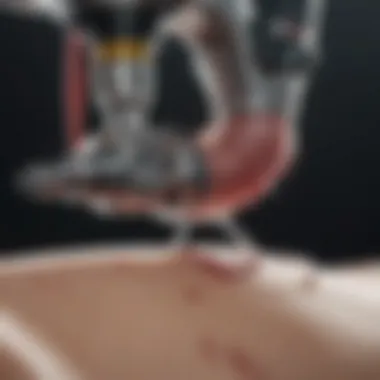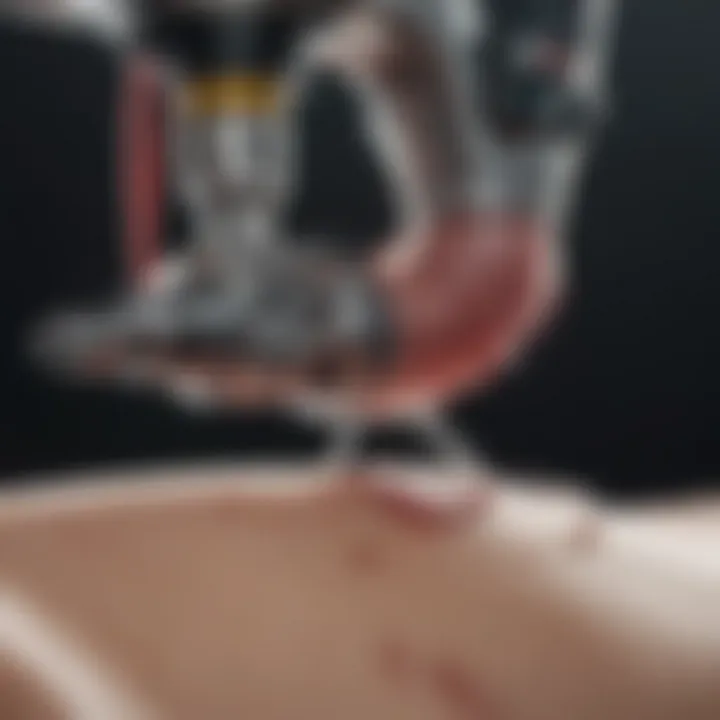Laparoscopic Resection: Comprehensive Analysis


Intro
Laparoscopic resection has become a cornerstone in contemporary surgical practices. This technique emphasizes minimal invasiveness, thereby offering crucial benefits such as reduced recovery time and less postoperative discomfort for patients. Surgeons increasingly adopt this method across various specialties, including gastrointestinal and oncological surgeries.
The approach relies on utilizing small incisions through which surgical tools and a camera are inserted. This setup allows surgeons to perform complex procedures with enhanced visibility and precision. As the medical field continues to evolve, understanding the nuances of laparoscopic resection is vital for students, researchers, and practicing professionals.
Research Overview
Summary of Key Findings
Research and clinical studies indicate that laparoscopic resection not only shortens hospital stays but also significantly lowers rates of complications. In many cases, patients experience quicker returns to normal activities. The ability to visualize the operative field more clearly may contribute to these outcomes, as surgeons can navigate intricate anatomical structures with greater accuracy.
Background and Context
Historically, traditional open surgery posed several challenges, including larger incisions, increased pain, and longer recovery periods. Over the last few decades, advancements in technology and surgical techniques have led to the development of laparoscopic methods. This transition reflects a growing preference among both patients and healthcare providers for less invasive options.
Methodology
Experimental Design
The research undertaken in this article encompassed a comprehensive analysis of existing literature on laparoscopic resection. Various studies highlighted outcomes related to recovery times, complication rates, and overall patient satisfaction. The findings were categorized and synthesized to present a clear picture of the current landscape of laparoscopic procedures.
Data Collection Techniques
- Review of Clinical Trials: Numerous peer-reviewed studies provided data on laparoscopic resection outcomes.
- Surveys and Interviews: Feedback from practicing surgeons and patients contributed to a more rounded perspective of the technique's effectiveness.
"The evolution of laparoscopic techniques has revolutionized the surgical field, offering remarkable benefits to patients while advancing surgical capabilities."
As the article progresses, it will explore the detailed methodologies, patient benefits, and clinical applications of laparoscopic resection, emphasizing its significance in modern surgical practice.
Foreword to Laparoscopic Resection
Laparoscopic resection represents a transformative approach in surgical medicine. This method, characterized by its minimally invasive nature, allows for significant advantages over traditional open surgery. As this article explores, understanding laparoscopic resection is essential for professionals in healthcare, educators keen on surgical methods, and researchers analyzing its outcomes.
The focus of laparoscopic resection is not only on the technical aspects of the procedure but also its implications for patient care. As patients demand less invasive options with faster recovery times, the relevance of this technique increases.
Definition and Overview
Laparoscopic resection involves the surgical removal of tissue or organs through small incisions assisted by a camera and specialized instruments. This procedure minimizes trauma to surrounding tissues, which leads to lower blood loss and reduced postoperative pain. Patients typically experience a shorter hospital stay and faster return to daily activities compared to open surgery. By understanding this definition, it becomes clear why many surgeons choose this method in suitable cases.
Historical Context
The development of laparoscopic surgery dates back to the late 20th century. Early attempts at minimally invasive techniques were met with skepticism due to perceived risks and limitations. However, continued advancements in technology and surgical methods have led to widespread acceptance in recent years. Today, laparoscopic resection is a staple in various surgical disciplines, including oncology and general surgery. This shift represents a significant evolution in surgical practice, emphasizing the importance of ongoing training and development among surgeons to master these techniques.
The Laparoscopic Procedure
Laparoscopic resection has transformed many surgical specialties. This method is essential in today's medical practice due to its minimally invasive nature. Surgeons prefer it as it provides patients with various benefits, such as shorter recovery time and less postoperative discomfort. Understanding the laparoscopic procedure is critical to appreciating its implications in clinical settings.
Equipment and Tools Used
The tools and equipment utilized in laparoscopic surgery are specific and sophisticated. The most common items include:
- Laparoscope: A thin tube equipped with a camera that allows the surgeon to view the surgical area on a monitor.
- Trocars: Sharp, pointed instruments that create access points through the abdominal wall. They facilitate the insertion of laparoscopic instruments without large incisions.
- Optical devices: Cameras and light sources that enhance visualization of internal structures.
- Surgical instruments: Graspers, scissors, and needle holders adapted for use in small surgical openings.
Each tool serves a specific purpose, thus ensuring precision and effectiveness during procedures.
Step-by-Step Surgical Technique
The laparoscopic approach follows a systematic surgical technique:
- Preparation: Anesthetize the patient and position them appropriately.
- Creation of Ports: Small incisions made in the abdomen allow access to the laparoscope and other instruments.
- Insufflation: Carbon dioxide gas inflates the abdomen to give the surgeon a better view and space to work.
- Surgical Resection: Surgeons manipulate instruments through the ports, performing the resection.
- Closure: The instruments are removed, the gas is let out, and the small incisions are sutured.
This approach minimizes tissue trauma and contributes to quicker recovery for patients.
Types of Laparoscopic Resection
Laparoscopic resection is categorized into three main types:


Partial Resection
Partial resection involves the removal of a specific part of an organ while preserving the remaining tissue. This method is significant because it can maintain some organ function, which is essential in organs like the liver and kidneys. Its key characteristic is the ability to remove diseased tissue while maintaining overall organ health. This option is popular due to the potential for a less complicated recovery and less extensive damage to nearby structures.
Advantages of partial resection include:
- Minimization of postoperative complications.
- Shorter recovery times compared to more extensive resections.
However, careful evaluation of the patient's condition is necessary to determine candidacy for this type of procedure.
Total Resection
Total resection involves the complete removal of an entire organ. This approach is often used in cases like cancer where complete excision is required for treatment. The primary characteristic of total resection is its definitive treatment option for malignant conditions. It is a beneficial choice when the disease risk surpasses the potential complications of surgery.
Notable features include:
- Comprehensive tissue removal which can lead to improved long-term outcomes for certain patients.
- Possible increased risk of complications given the extent of the surgery.
Patients must weigh the benefits of total resection against the greater recovery challenges associated with it.
Segmental Resection
Segmental resection involves removing a specific segment or section of an organ. This technique has gained traction in certain scenarios where it allows for targeted removal while preserving vital functions of the organ. Its key characteristic is its selective approach to treatment, which can somewhat mitigate risks linked to more extensive surgeries.
The benefits of segmental resection include:
- Retention of a significant portion of the organ, maintaining its function post-surgery.
- Suitable for benign conditions or early-stage malignancies where a complete resection is not deemed necessary.
However, it may not always be adequate for advanced disease, necessitating thorough evaluation during preoperative planning.
Understanding different types of laparoscopic resections helps surgeons tailor interventions according to individual patient needs and conditions.
Indications for Laparoscopic Resection
Laparoscopic resection is a surgical procedure that has been increasingly utilized in various medical disciplines. Understanding the indications for this approach is crucial for both practitioners and patients. The decision to proceed with a laparoscopic technique often hinges on multiple factors such as the type of condition being treated, patient health status, and previous surgical history. Generally speaking, any surgical intervention, particularly resection, must weigh the balance between potential benefits and risks.
In essence, the indications for laparoscopic resection can be categorized into oncological applications and treatment for benign conditions. Each indication reveals a unique aspect of laparoscopic resection's utility and effectiveness in contemporary surgical practice.
Oncological Applications
Oncological applications of laparoscopic resection are significant, largely due to the technique's ability to provide effective treatment while limiting trauma to the body. Malignancies such as colorectal cancer, gastric cancer, and even certain types of liver tumors can be effectively managed through this less invasive approach. The rationale behind utilizing laparoscopic methods in cancer cases stems from both the need to remove tumors and preserve as much healthy tissue as possible.
- Colorectal Cancer: Laparoscopic approaches have shown promise in managing colorectal cancers. Studies indicate that laparoscopic resections can yield oncological outcomes comparable to open surgery, with advantages in recovery and hospital stay.
- Gastric Cancer: The use of laparoscopy in gastric cancer surgery allows for extended lymph node dissection, which is crucial in staging and treatment. Laparoscopic techniques are less traumatic and promote faster recovery without compromising the surgical goals.
- Liver Tumors: In selected patients, laparoscopic resection of liver tumors also presents as a viable option. It reduces postoperative pain and can lead to quicker recovery times, which is beneficial in a population that may already be facing systemic illness.
While the efficacy of laparoscopic oncological resections is widely recognized, it is crucial to note that a thorough patient evaluation is needed to determine if a patient is a suitable candidate for this type of surgery.
Benign Conditions
Laparoscopic resection is not limited to oncology; it is also employed in treating various benign conditions. The procedure provides numerous advantages, including smaller incisions, reduced pain, and shorter recovery periods. Conditions treated laparoscopically often include:
- Diverticulitis: Patients suffering from recurrent diverticulitis may benefit from laparoscopic sigmoid colectomy, which can resolve discomfort while minimizing recovery time.
- Benign Tumors: Laparoscopic techniques are particularly well-suited for the removal of benign tumors in organs like the gallbladder or kidneys. For instance, a laparoscopic cholecystectomy is the standard treatment for symptomatic gallbladder stones.
- Focal Liver Lesions: Non-cancerous liver lesions can also be treated laparoscopically, allowing for effective management of these conditions with reduced complications.
Advantages of Laparoscopic Resection
Laparoscopic resection offers several important advantages compared to traditional open surgery. These benefits not only enhance patient recovery and satisfaction but also reflect the evolving preferences within the surgical community. Understanding these advantages can help inform both medical practitioners and patients in making decisions regarding surgical options.
Reduced Recovery Time
One of the main advantages of laparoscopic resection is its potential for reduced recovery time. Patients undergoing this minimally invasive procedure often experience shorter hospital stays, with many being discharged within 24–48 hours post-surgery. This is in stark contrast to open surgery, where hospital stays can extend to several days or even weeks. The quicker recovery can largely be attributed to smaller incisions that result in less trauma to the body.
Moreover, laparoscopic techniques commonly result in a faster return to daily activities. Studies suggest that patients may resume normal routines such as work and exercise within a matter of weeks, as opposed to the longer recovery periods associated with more invasive approaches. This efficiency not only benefits the patient's quality of life but also reduces overall healthcare costs.
Minimized Pain and Discomfort
Minimized pain and discomfort is another significant advantage associated with laparoscopic resection. The smaller incisions lead to less nerve and tissue damage, often resulting in a decrease in post-operative pain levels. Many patients require lower dosages of analgesics, which may lessen the risk of side effects associated with pain medications.
Furthermore, the minimally invasive nature of the procedure can contribute to a more pleasant recovery experience. Patients frequently report better satisfaction regarding their comfort levels during the initial days following surgery. This aspect is crucial because lower levels of pain can improve mobility and the overall rehabilitation process, leading to enhanced outcomes.
Lower Risk of Complications


The lower risk of complications is perhaps the most significant advantage of laparoscopic resection. Surgical interventions always carry some risk, but studies have consistently shown that laparoscopic procedures tend to result in fewer complications compared to traditional methods.
Some reasons for this include:
- Reduced likelihood of infection due to smaller wound sizes.
- Lower rates of postoperative blood loss, which can necessitate transfusions.
- Less chance of adhesions forming during the healing process, which can lead to chronic pain or obstructions.
Additionally, laparoscopic surgery allows surgeons to utilize advanced imaging tools, offering improved visibility and precision during the procedure. This technological enhancement plays a vital role in navigating complex anatomy and minimizing surgical errors, further contributing to the favorable risk profile of laparoscopic resection.
"By employing laparoscopic techniques, surgeons can offer patients a modern approach that aligns with current expectations for patient care and surgical recovery."
In summary, the advantages of laparoscopic resection are numerous and prominent. The reduced recovery time, minimized pain, and lower risk of complications make it an appealing option for both patients and healthcare providers. These factors contribute to ongoing research and interest in expanding the application of laparoscopic methods in various surgical specialties.
Risks and Limitations
Understanding the risks and limitations associated with laparoscopic resection is crucial for both medical professionals and patients. While this surgical technique offers many advantages, it is not without potential downsides. Awareness of these issues ensures that informed decisions can be made regarding treatment options.
Potential Surgical Complications
Surgical complications, although rare, can occur during laparoscopic resection. Key potential issues include bleeding, infection, and injury to nearby organs. These complications can significantly impact patient recovery and outcomes. For example:
- Bleeding: This may arise from the surgical site itself or from surrounding blood vessels. If excessive bleeding occurs, it may necessitate conversion to open surgery.
- Infection: Post-operative infections can lead to prolonged hospital stays and may require additional treatments such as antibiotics or even surgical intervention.
- Organ Injury: Accidental injury to structures such as the intestines or blood vessels is possible, particularly in complex cases. This can lead to serious complications that require further treatment.
Patients must be cautiously monitored, and intraoperative protocols must be strictly followed to minimize these risks. Surgeons should discuss these possibilities during the pre-operative consultation, allowing patients to understand their specific risks based on individual health profiles.
Patient-Specific Factors
Not every patient is a suitable candidate for laparoscopic resection. Various patient-specific factors can influence both the risks and the outcomes of the procedure. These include:
- Underlying Health Conditions: Conditions like obesity, heart disease, or chronic lung disease can complicate surgery and recovery.
- Age: Older patients may experience different risks compared to younger individuals, such as longer recovery times or increased likelihood of complications.
- Prior Surgeries: A history of previous abdominal surgeries may alter anatomy and increase the difficulty of laparoscopic procedures, raising the risk of complications.
- Tumor Characteristics: The size, location, and type of tumor being resected can determine whether laparoscopic methods are appropriate.
Informed consent must involve a discussion of these patient-specific factors, ensuring that individuals understand how their unique circumstances may impact surgical risks.
In summary, while laparoscopic resection presents numerous benefits, it is essential that patients and surgeons remain aware of the potential risks and limitations. This understanding fosters informed decision-making and enhances the overall success of the surgical experience.
Post-operative Care
Post-operative care plays a crucial role in the recovery process following laparoscopic resection. Proper management during this phase can greatly influence patient outcomes and hasten the return to normal activities. It covers a broad range of considerations, including pain management, wound care, and monitoring for complications. The goal is to ensure the patient heals effectively while minimizing discomfort and reducing the risk of post-operative complications.
Initial Recovery Phase
During the initial recovery phase, which typically spans the first few days after surgery, patients are often monitored closely in a clinical setting. They may experience pain, fatigue, and some discomfort. Therefore, effective pain management is essential. Medications prescribed, such as acetaminophen and non-steroidal anti-inflammatory drugs, help control pain levels without causing significant side effects. In some cases, stronger medications might be used.
In addition to pain management, the surgical site must be cared for properly. Patients are advised on cleaning the area and identifying signs of infection, such as increased redness, swelling, or discharge. Regular check-ups are critical during this period to evaluate the surgical site and adjust care as necessary.
Patients are encouraged to engage in light, guided activity shortly after surgery. This may include walking or gentle stretching to promote circulation and prevent complications such as deep vein thrombosis. These recommendations should be tailored to the individual's condition and based on the surgeon's assessment.
Long-term Monitoring
As recovery progresses, long-term monitoring becomes equally important. This phase typically begins after the initial recovery period and may extend for several months. Healthcare providers commonly schedule follow-up appointments to assess healing and detect potential complications.
Patients should also be informed about potential late effects of surgery. These can include changes in dietary requirements or gastrointestinal function, depending on the area of resection. Knowledge about such changes aids patients in adapting their lifestyles accordingly.
Furthermore, education plays a pivotal role. Providing clear guidance about signs that warrant immediate medical attention ensures patients remain vigilant after their discharge. This includes severe pain, persistent vomiting, or unusual changes in bowel habits. Through these measures, healthcare providers support patients in achieving optimal recovery outcomes.
Comparative Analysis
The comparative analysis segment of this article aims to explore and clarify the distinctions between laparoscopic resection and traditional open surgery. Understanding these differences is crucial for evaluating surgical options and guiding clinical decisions. This analysis provides insights into procedural efficacy, recovery metrics, and overall patient experiences.
Laparoscopic vs Traditional Open Surgery
In recent years, laparoscopic resection has emerged as an appealing alternative to traditional open surgery. Laparoscopic techniques utilize small incisions, allowing surgeons to perform procedures with minimal disruption to the body's tissues. In contrast, traditional open surgery typically requires larger incisions, leading to increased recovery times and more postoperative discomfort.
Several factors highlight the advantages of laparoscopic resection:
- Minimally Invasive Nature: Laparoscopic rseaction reduces scar formation and enhances cosmetic outcomes.
- Reduced Pain: Patients often report less pain postoperatively compared to open surgery.
- Shorter Hospital Stays: Many laparoscopic procedures allow discharge within a day or two.
- Faster Recovery: Most patients resume normal activities much sooner than with open surgery.
However, it’s important to acknowledge certain limitations inherent to laparoscopic techniques. For example, some complex cases may still necessitate an open approach due to accessibility and visualization challenges during surgery.


Clinical Outcomes and Patient Satisfaction
The effectiveness of laparoscopic resection is largely measured through clinical outcomes and patient satisfaction. Research consistently shows that patients undergoing laparoscopic procedures often report superior overall satisfaction compared to their counterparts who undergo traditional methods.
Some key clinical outcomes noted in studies include:
- Lower Rates of Complications: Laparoscopic surgery generally presents fewer complications like infections and prolonged healing.
- Shortened Recovery Timeframes: Patients find laparoscopic options lead to decreased downtime, promoting a quicker return to work and daily activities.
Furthermore, many patients favor the less invasive nature of laparoscopic surgery. A positive perception surrounding less pain and shorter recovery time greatly contributes to the overall satisfaction ratings among patients.
"Patient satisfaction is not merely about outcomes; it encompasses the entire surgical experience, including the support from the healthcare team and recovery process."
Technological Advances in Laparoscopic Surgery
Technological advances in laparoscopic surgery play a crucial role in transforming surgical practices. As minimally invasive techniques grow in popularity, innovations help enhance precision, reduce recovery times, and improve patient outcomes. New technologies change how surgeons approach operations, offering better instruments and methods. Understanding these advances is essential for both medical professionals and patients looking to grasp the future of surgery.
Robot-Assisted Laparoscopy
Robot-assisted laparoscopy represents a significant leap in surgical capabilities. This technique involves using robotic systems, such as the da Vinci Surgical System, which allows surgeons to perform complex procedures through tiny incisions. The robotic arms provide enhanced dexterity and stability, enabling greater control during surgery.
With this technology, surgeons can manipulate instruments in ways that are hard to achieve with traditional laparoscopic tools. This precision translates to minimally invasive interventions that reduce trauma and improve recovery.
"Robotic surgery offers a unique advantage by allowing surgeons to make intricate movements, increasing the accuracy of the procedure."
Additionally, the integration of 3D imaging provides surgeons with a better view of the surgical field. This visual enhancement helps in identifying anatomical structures clearly, which can be vital during critical operations. Most importantly, it enhances the surgeon's confidence in performing complex resections or repairs.
Improved Imaging Techniques
Imaging techniques have evolved substantially. The use of high-definition cameras in laparoscopic operations allows for increased visibility in the surgical field. These cameras enable surgeons to see fine details of the anatomy, which is essential for accurate dissections.
Other advancements include fluorescence imaging and augmented reality tools that aid in identifying tumors or blood vessels more effectively. These technologies can highlight specific structures, thus minimizing the risk of damage to surrounding tissues and optimizing surgical outcomes.
When experiencing complex cases, imaging assists in preoperative planning and intraoperative navigation. Improved imaging also contributes to better postoperative assessments, ensuring that the patient is healing correctly and reducing the chances of complications.
Future Trends in Laparoscopic Resection
The field of laparoscopic resection is witnessing rapid advancements that are transforming surgical practices. Understanding these future trends is essential for medical professionals, students, and researchers who aim to keep pace with these important developments. Innovations in technology and surgical techniques continuously enhance how procedures are performed, leading to improved patient outcomes, streamlined workflows, and reduced recovery times.
Innovations in Surgical Techniques
Emerging innovations in surgical techniques are pivotal in redefining laparoscopic resection. The integration of technologies such as augmented reality and advanced imaging systems provide surgeons with real-time data that enhance visibility and precision during procedures. For instance, three-dimensional imaging aids in mapping out anatomy, which can be particularly beneficial in complex resections. This leads to better-informed decision-making and minimizes the risk of complications.
Moreover, the evolution of energy devices has improved the efficiency of tissue manipulation. Devices like the Harmonic Scalpel and LigaSure offer better control over bleeding and equal precision in cutting tissue, which is crucial in laparoscopic surgery.
Training programs are also adapting to these innovations. Surgeons are increasingly gaining exposure to virtual reality simulations, allowing them to practice techniques without the risk involved in live procedures. This type of training not only improves skill but also boosts confidence among surgical teams.
Evolving Guidelines and Protocols
As innovations make their mark, evolving guidelines and protocols are necessary to ensure safety and efficacy in laparoscopic resection. Professional organizations such as the Society of American Gastrointestinal and Endoscopic Surgeons (SAGES) are regularly updating their guidelines based on current research and technological advancements.
Best practices now incorporate a more comprehensive approach to preoperative assessment and risk stratification. Surgeons are encouraged to engage in multidisciplinary team discussions to determine the most appropriate surgical methods for each individual patient. Furthermore, postoperative care protocols are evolving to implement enhanced recovery after surgery (ERAS) principles. These protocols emphasize early mobilization and optimized pain management to facilitate faster recoveries and reduce hospital stays.
"To maintain quality and safety, it is crucial that surgical teams adapt continually through updated practices based on the latest evidence."
Overall, future trends in laparoscopic resection signify a shift towards more individualized, precise, and efficient surgical care. Keeping abreast of these changes is vital for anyone involved in the surgical field, leading not only to personal growth but also to improved patient outcomes and satisfaction.
Ending
The conclusion serves as a pivotal part of this article, encapsulating the essence of laparoscopic resection and reinforcing its relevance in modern surgical practices. By summarizing the critical components covered, this section creates a connection between procedural methodologies and their practical applications in the medical field.
Summary of Findings
Throughout this discussion, we have explored various aspects of laparoscopic resection. Major findings include:
- Procedural Efficiency: Laparoscopic techniques promote less invasive surgery with minimal incisions, resulting in reduced recovery times for patients.
- Clinical Benefits: Patients typically experience less postoperative pain and shorter hospital stays than those undergoing traditional surgery.
- Risks and Benefits: While there are inherent risks associated with any surgical procedure, the low complication rates for laparoscopic resections underline its safety.
- Technological Innovations: Developments such as robot-assisted surgery and improved imaging have enhanced the effectiveness and precision of laparoscopic techniques.
A comprehensive understanding of these factors is essential for both practitioners and patients to make informed surgical decisions.
Implications for Future Research
Future research in laparoscopic resection is essential to further enhance surgical techniques and patient outcomes. Some key areas for exploration include:
- Enhanced Techniques: Investigate the development of new techniques that could improve the precision and safety of laparoscopic procedures.
- Longitudinal Studies: Conduct studies that examine long-term patient outcomes post-laparoscopic resection, focusing on quality of life and recurrence rates of treated conditions.
- Comparative Analysis: More in-depth comparative analyses of laparoscopic versus traditional surgical outcomes could strengthen the case for laparoscopic approaches across various medical fields.
- Patient Selection Protocols: Identifying the most suitable candidates for laparoscopic procedures could optimize surgical success rates further.
As the landscape of healthcare continuously evolves, the comparative brightness of laparoscopic resection against traditional methods remains an area with vast potential for inquiry and improvement.







